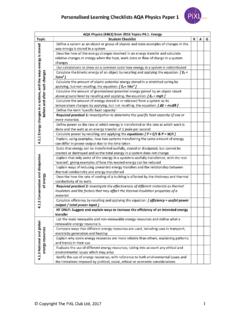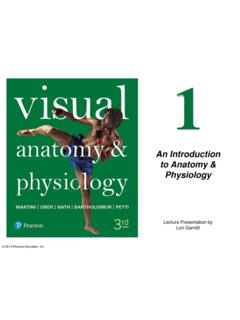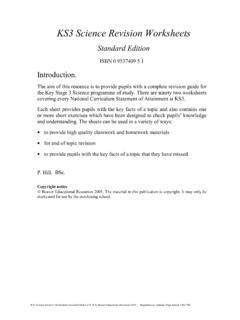Transcription of Personalised Learning Checklists AQA Biology Paper 1
1 Personalised Learning Checklists AQA Biology Paper 1 Copyright The PiXL Club Ltd, 2017 1 AQA Biology (8461) from 2016 Topic Cell Biology Topic Student Checklist R A G Cell structure Use the terms 'eukaryotic' and 'prokaryotic' to describe types of cells Describe the features of bacterial (prokaryotic) cells Demonstrate an understanding of the scale and size of cells and be able to make order of magnitude calculations, inc standard form Recall the structures found in animal and plant (eukaryotic) cells inc algal cells Use estimations and explain when they should be used to judge the relative size or area of sub-cellular structures Required practical 1.
2 Use a light microscope to observe, draw and label a selection of plant and animal cells Describe the functions of the structures in animal and plant (eukaryotic) cells Describe what a specialised cell is, including examples for plants and animals Describe what differentiation is, including differences between animals and plants Define the terms magnification and resolution Compare electron and light microscopes in terms of their magnification and resolution Carry out calculations involving magnification using the formula: magnification = size of image/ size of real object -inc standard form Bio ONLY: Describe how bacteria reproduce and the conditions required Bio ONLY: Describe how to prepare an uncontaminated culture Bio ONLY: Calculate cross-sectional areas of colonies or clear areas around colonies using r Bio ONLY: Calculate the number of bacteria in a population after a certain time if given the mean division time Bio & HT ONLY: Express answers for last two points in standard form Required practical 2.
3 Investigate the effect of antiseptics or antibiotics on bacterial growth using agar plates and measuring zones of inhibition Cell division Describe how genetic information is stored in the nucleus of a cell (inc genes & chromosomes) Describe the processes that happen during the cell cycle, including mitosis (inc recognise and describe where mitosis occurs) Describe stem cells, including sources of stem cells in plants and animals and their roles Describe the use of stem cells in the production of plant clones and therapeutic cloning Discuss the potential risks, benefits and issues with using stem cells in medical research/treatments (inc diabetes and paralysis) Transport in cells Describe the process of diffusion, including examples Explain how diffusion is affected by different factors Define and explain "surface area to volume ratio", and how this relates to single-celled and multicellular organisms (inc calculations)
4 Explain how the effectiveness of an exchange surface can be increased, inc examples of adaptations for small intestines, lungs, gills roots & leaves Describe the process of osmosis (inc calculation of water uptake & percentage gain and loss of mass of plant tissue) Required practical 3: investigate the effect of a range of concentrations of salt or sugar solutions on the mass of plant tissue Describe the process of active transport, including examples - gut and roots Explain the differences between diffusion, osmosis and active transport Personalised Learning Checklists AQA Biology Paper 1 Copyright The PiXL Club Ltd, 2017 2 AQA Biology (8461)
5 From 2016 Topic Organisation Topic Student Checklist R A G Principles of organisation & Animal tissues, organs and organ systems Describe the levels of organisation within living organisms Describe the digestive system and how it works as an organ system (from KS3) Describe basic features of enzymes (inc rate calculations for chemical reactions) Describe the lock and key theory as a model of enzyme action and explain how the shape a of the active sites makes the enzyme specific Explain the effect of temperature and pH on enzymes Describe the digestive enzymes, including their names, sites of production and actions Describe how the products of digestion are used Describe the features and functions of bile and state where it is produced and released from Required practical 4: use qualitative reagents to test for a range of carbohydrates, lipids and proteins Required practical 5.
6 Investigate the effect of pH on the rate of reaction of amylase enzyme Describe the structure of the human heart and lungs (inc how lungs are adapted for gaseous exchange) Explain how the heart moves blood around the body (inc role and position of the aorta, vena cava, pulmonary artery & vein and coronary arteries) Explain how the natural resting heart rate is controlled and how irregularities can be corrected Describe the structure and function of arteries, veins and capillaries Use simple compound measures such as rate and carry out rate calculations for blood flow Describe blood and identify its different components, inc identifying blood cells from photographs/diagrams Describe the functions of blood components, including adaptations to function Describe what happens in coronary heart disease and what statins are used for Describe and evaluate treatments for coronary heart disease and heart failure (inc drugs.)
7 Mechanical devices or transplant) Recall that heart valves can become faulty and describe the consequences of this Describe how patients can be treated in the case of heart failure Describe health and the explain causes of ill-health and the relationship between health and disease Describe how different types of diseases may interact and translate disease incidence information between graphical and numerical forms Describe what risk factors are and give examples discussing human and financial costs of non-communicable diseases at local, national and global levels Describe what cancer is and explain the difference between benign and malignant tumours Describe the known risk factors for cancer, including genetic and lifestyle risk factors Plant tissues, organs and system Describe plant tissues (epidermal, palisade mesophyll, spongy mesophyll, xylem, phloem and meristem) and describe their functions Explain how the structure of plant tissues are related to their function within the leaf (plant organ)
8 Inc stomata and guard cells Recall the plant parts that form a plant organ system that transports substances around the plant Explain how root hair cells, xylem and phloem are adapted to their functions Describe the process of transpiration and translocation including the role of the different plant tissues Explain how the rate of transpiration can be affected by different factors (inc naming the factors) Describe the role of stomata and guard cells in the control of gas exchange and water loss Personalised Learning Checklists AQA Biology Paper 1 Copyright The PiXL Club Ltd, 2017 3 AQA Biology (8461) from 2016 Topic Infection and response Topic Student Checklist R A G Communicable diseases Explain what a pathogen is and how pathogens are spread (inc how viruses, bacteria, protists and fungi are spread in animals and plants)
9 Explain how pathogenic bacteria and viruses cause damage in the body Explain how the spread of diseases can be reduced or prevented Describe measles, HIV and tobacco mosaic virus as examples of viral pathogens Describe salmonella food poisoning and gonorrhoea as examples of bacterial pathogens Describe the signs, transmission and treatment of rose black spot infection in plants as an example of fungal pathogens Describe the symptoms, transmission and control of malaria, including knowledge of the mosquito vector as an example of a protists pathogen Describe defences that stop pathogens entering the human body (inc skin, nose, trachea & windpipe, stomach)
10 Recall the role of the immune system Describe how white blood cells destroy pathogens Describe how vaccination works, including at the population level Explain how antibiotics and painkillers are used to treat diseases, including their limitations Describe how sources for drugs have changed over time and give some examples Describe how new drugs are tested, including pre-clinical testing and clinical trials (inc double blind trials and placebos) Monoclonal antibodies Bio & HT ONLY: Describe what monoclonal antibodies are and why they are useful Bio & HT ONLY: Describe how monoclonal antibodies are produced Bio & HT ONLY: Explain how monoclonal antibodies are used for diagnosis, research, chemical testing and disease treatments Bio & HT ONLY: Evaluate the advantages and disadvantages of monoclonal antibodies (inc side effects) Bio & HT ONLY: Describe some observable signs of plant disease, and how plant diseases can be identified Plant disease Bio ONLY: Give examples of plant pathogens Bio ONLY: Give examples of plant ion deficiencies and their effects Bio ONLY.




